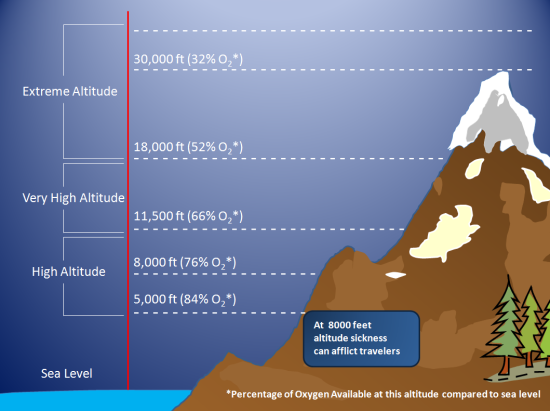How to Avoid Altitude Sickness While Trekking in Nepal
Trekking in Nepal is a dream for many adventurers, offering stunning landscapes, rich cultural experiences, and the opportunity to explore some of the highest peaks on the planet. However, with the allure of these majestic mountains comes a significant challenge: altitude sickness, or acute mountain sickness (AMS). Understanding altitude sickness and employing effective strategies to prevent it is essential for ensuring a safe and enjoyable trekking experience. In this article, we’ll delve into what altitude sickness is, its symptoms, and practical strategies to prevent it while trekking in the breathtaking mountains of Nepal.
Understanding Altitude Sickness
What Is Altitude Sickness?
Altitude sickness occurs when the body struggles to adapt to the reduced oxygen levels at high altitudes. It can affect anyone, regardless of age, fitness level, or previous experience at altitude. While some trekkers may acclimatize without issues, others might develop symptoms after just a few hours at high elevation.
Symptoms of Altitude Sickness
Symptoms can vary from mild to severe and typically manifest within hours of ascending to high altitudes. Common symptoms include:
- Headache: Often the first sign of altitude sickness, ranging from mild discomfort to severe pain.
- Nausea and Vomiting: Many trekkers experience gastrointestinal discomfort, which can lead to a lack of appetite and dehydration.
- Dizziness: A feeling of light-headedness or confusion, which can impair judgment and decision-making.
- Fatigue: An unusual level of tiredness, even with minimal exertion, making the trek more challenging.
- Sleep Disturbances: Insomnia or disrupted sleep patterns, which can exacerbate fatigue.
- Shortness of Breath: Difficulty breathing, even at rest, indicating that the body is struggling to get enough oxygen.
In severe cases, altitude sickness can escalate into high-altitude pulmonary edema (HAPE) or high-altitude cerebral edema (HACE), both life-threatening conditions that require immediate medical intervention.
Why Does Altitude Sickness Occur?
At higher altitudes, the air pressure decreases, which results in lower oxygen levels. The body typically adapts to this change through various physiological responses, such as increasing breathing rate, heart rate, and producing more red blood cells. However, this acclimatization process takes time, and if individuals ascend too quickly, they may overwhelm their body’s ability to adjust.
Preparation Before the Trek
1. Choose Your Trek Wisely
Selecting the right trekking route is crucial for minimizing the risk of altitude sickness. Here are some popular treks in Nepal, each with unique elevation profiles and acclimatization opportunities:
- Everest Base Camp Trek: One of the most famous treks in the world, reaching an altitude of 5,364 meters (17,598 feet). The trek offers several acclimatization days in places like Namche Bazaar.
- Annapurna Circuit: This route has varied altitudes and beautiful landscapes, with a maximum elevation of around 5,416 meters (17,769 feet) at Thorong La Pass. Its gradual ascent helps trekkers acclimatize effectively.
- Langtang Valley Trek: A slightly less crowded option, with a maximum elevation of 4,850 meters (15,919 feet). The trek provides ample opportunities for acclimatization and offers stunning views of the Langtang range.
- Gokyo Lakes Trek: This trek takes you to beautiful turquoise lakes at high altitudes, with a maximum elevation of 5,357 meters (17,575 feet). It includes acclimatization days that allow for a gradual ascent.
2. Gradual Ascent
The key to preventing altitude sickness lies in a gradual ascent. Here are some detailed strategies:
- Daily Elevation Gain: Limit your ascent to no more than 300-500 meters (1,000-1,600 feet) per day once above 3,000 meters (10,000 feet). This gradual approach allows your body time to adjust to the decreasing oxygen levels.
- Acclimatization Days: Schedule additional rest days at strategic points in your trek. For instance, after ascending to Namche Bazaar (3,440 meters), consider spending an extra day there to acclimatize before moving higher. This will help reduce the risk of altitude sickness significantly.
- Listen to Your Body: Every individual reacts differently to altitude. If you feel symptoms developing, even after following these guidelines, don’t hesitate to slow down your ascent or take an extra rest day.
3. Stay Fit and Healthy
Physical fitness can significantly influence your ability to adapt to high altitudes. Here’s how to prepare your body for the trek:
- Cardiovascular Fitness: Engage in regular cardiovascular exercises, such as running, cycling, or swimming, to improve your overall stamina and lung capacity. Aim for at least 30 minutes of aerobic exercise most days of the week.
- Strength Training: Incorporate strength training into your routine to enhance your leg muscles, which are essential for trekking. Focus on exercises like squats, lunges, and step-ups to build endurance and strength in your lower body.
- Practice Trekking: If possible, practice trekking at higher altitudes or on hilly terrain. This helps your body acclimatize to the demands of trekking and allows you to experience the physical exertion before your main trek.
Nutrition and Hydration
4. Stay Hydrated
Hydration plays a critical role in acclimatization and overall health during your trek. Here are some tips to stay properly hydrated:
- Water Intake: Aim to drink 3-4 liters of water daily, depending on your activity level and climate conditions. Trekking in high altitudes increases fluid loss through respiration and sweat, so maintaining hydration is crucial.
- Hydration Packs: Consider using a hydration pack or a water bottle with a built-in filter to ensure you always have access to clean drinking water. This can also help you track your water intake throughout the day.
- Electrolyte Balance: Include electrolyte-replenishing drinks or tablets in your hydration plan. At high altitudes, the risk of dehydration increases, and maintaining a proper balance of electrolytes can help prevent fatigue and muscle cramps.
5. Nutrition Matters
A well-balanced diet supports your body’s energy needs while trekking, especially at high altitudes. Here’s what to focus on:
- Carbohydrate-Rich Foods: Carbohydrates are vital as they provide energy for trekking. Prioritize foods like pasta, rice, bread, and potatoes, which are easily digestible and energy-dense.
- Frequent Small Meals: Eating smaller, more frequent meals helps maintain energy levels and can be easier to digest at altitude. Consider snacks like nuts, energy bars, and dried fruits for quick energy boosts on the trail.
- Hydration Foods: Incorporate foods with high water content, such as fruits and soups, to help with hydration. Staying hydrated can also aid in digestion and overall well-being at high altitudes.
Acclimatization Techniques
6. Climb High, Sleep Low
The “climb high, sleep low” technique is one of the most effective acclimatization strategies. Here’s how it works:
- Daytime Ascents: Plan to ascend to a higher altitude during the day while returning to a lower altitude to sleep. This method enhances the body’s ability to adjust to high altitudes without the stress of sleeping at elevation.
- Sample Itinerary: For example, during the Everest Base Camp trek, you can hike up to acclimatization points such as Namche Bazaar (3,440 meters) or even higher towards Everest View Hotel, then return to Namche to sleep.
7. Recognize Early Symptoms
Self-awareness is key to preventing altitude sickness. Trekkers should be vigilant about their bodies and recognize early symptoms. If you experience mild symptoms, take action immediately:
- Descend Immediately: If symptoms appear, descend to a lower altitude promptly. Even a drop of a few hundred meters can significantly alleviate symptoms.
- Rest and Hydrate: Take time to rest and ensure you’re drinking enough fluids. Often, hydration can alleviate mild symptoms like headaches and fatigue.
- Seek Help if Necessary: If symptoms worsen or do not improve, seek medical assistance. Don’t hesitate to communicate with your guide about how you’re feeling; they can provide support and advice.
8. Use Acclimatization Aids
Some trekkers consider using acclimatization aids such as herbal supplements or medications like acetazolamide (Diamox). Here’s what to know:
- Consult a Healthcare Professional: Before using any medications, consult with a healthcare professional who understands altitude sickness and can provide personalized recommendations based on your health history.
- Diamox: This medication can help prevent altitude sickness by encouraging breathing and helping the body acclimatize faster. However, it is not a substitute for proper acclimatization practices and should be used in conjunction with them.
Professional Guidance and Support
9. Seek Professional Guidance
Trekking with experienced guides can greatly enhance safety and ensure that you’re taking the necessary precautions against altitude sickness. Here are some benefits of hiring a guide:
- Local Knowledge: Experienced guides know the terrain and can assess your progress and well-being throughout the trek. They can also identify the best acclimatization spots along the route.
- Emergency Preparedness: Guides are trained to recognize symptoms of altitude sickness and know how to respond, including facilitating emergency evacuations if necessary. Having a guide with first aid training can be invaluable in remote areas.
- Group Support: Trekking with a group can provide motivation, support, and a shared experience. Sharing the journey with others can make the trek more enjoyable and help you cope with challenges together.

10. Travel Insurance
Before embarking on your trek, it’s essential to have travel insurance that covers altitude sickness and emergency evacuation. Here’s what to look for:
- Coverage for High Altitudes: Ensure your policy includes coverage for trekking at high altitudes (above 3,000 meters or 10,000 feet). Some policies may have specific clauses regarding altitude limits.
- Emergency Evacuation: Check that your policy covers emergency evacuation services in case of severe altitude sickness or other medical emergencies. In remote regions of Nepal, evacuations can be complex and costly without proper insurance.
Preparing for the Trek
11. Pack Smart
Packing the right gear is essential for your trekking experience. Here are some items to consider:
- Clothing: Layering is key. Pack moisture-wicking base layers, insulating mid-layers, and waterproof outer layers. Don’t forget a warm hat, gloves, and a buff or scarf for protection against the cold and wind.
- Footwear: Invest in good-quality trekking boots that provide support and are broken in before the trek. Bring lightweight sandals or camp shoes for comfort at lower altitudes.
- First Aid Kit: Include items like pain relievers, anti-nausea medication, and basic first-aid supplies. Consider carrying Diamox if advised by a doctor, as well as altitude sickness medications recommended by your healthcare provider.
12. Mental Preparation
Trekking at high altitudes can be mentally challenging. Prepare yourself by:
- Setting Realistic Expectations: Understand that altitude sickness can affect anyone, and being prepared for slow progress can help manage frustration. Be flexible with your plans and open to changes in your itinerary.
- Staying Positive: Cultivate a positive mindset and remain adaptable. Developing resilience can enhance your experience and help you navigate challenges more effectively.
- Mindfulness and Relaxation Techniques: Consider incorporating mindfulness or relaxation techniques into your routine. Practicing deep breathing, meditation, or yoga can help you stay centered and manage stress while trekking.
Trekking in Nepal is an incredible adventure filled with awe-inspiring landscapes and cultural experiences. However, altitude sickness is a significant risk that can affect anyone, regardless of fitness level or experience. By understanding altitude sickness, taking proactive steps to prevent it, and listening to your body, you can enjoy a safe and memorable trekking experience.
Whether you’re gazing at the majestic peaks of the Himalayas or mingling with local villagers, remember that preparation and awareness are key. Equip yourself with knowledge, stay hydrated, choose your route wisely, and consider the importance of acclimatization. With the right approach, you can conquer the heights of Nepal while keeping altitude sickness at bay.
Ready to embark on the adventure of a lifetime? At EBC Trek Dot Net, we offer expertly guided treks through the breathtaking landscapes of Nepal, ensuring you have the best experience while minimizing the risk of altitude sickness. Visit our website to explore our trekking packages, access essential tips for a safe journey, and connect with fellow adventurers. Don’t wait—secure your spot today and get ready to conquer the majestic Himalayas!
